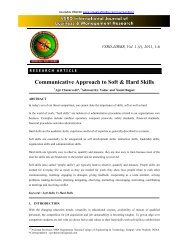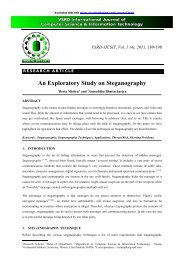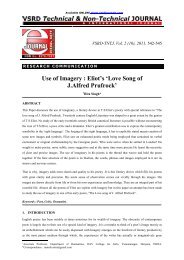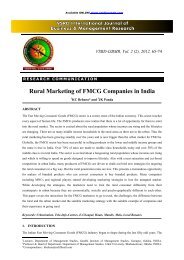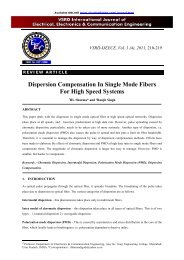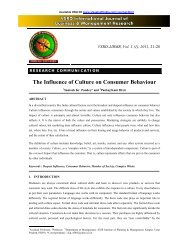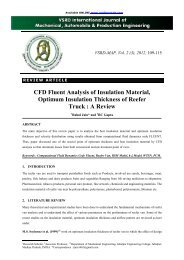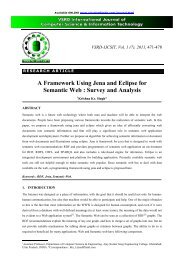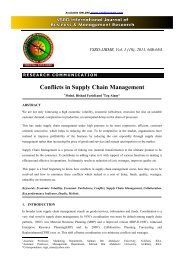Employee Involvement - VSRD INTERNATIONAL JOURNALS ...
Employee Involvement - VSRD INTERNATIONAL JOURNALS ...
Employee Involvement - VSRD INTERNATIONAL JOURNALS ...
Create successful ePaper yourself
Turn your PDF publications into a flip-book with our unique Google optimized e-Paper software.
Available ONLINE www.vsrdjournals.com<br />
R E S E A R C H C O M M U N II C A T II O N<br />
ABSTRACT<br />
____________________________<br />
<strong>VSRD</strong>-IJBMR, Vol. 1 (8), 2011, 554-560<br />
<strong>Employee</strong> <strong>Involvement</strong> : An Approach to<br />
Organizational Development & Change<br />
1 Shivangee Singh* and 2 Pankaj Kant Dixit<br />
Human capital is the real asset for any organization. All other resources are utilized and managed by human<br />
resources only. So, it is very important to gain the involvement of these human resources in every area of work<br />
to ensure performance improvement & members’ satisfaction. One simple philosophy for this is “<strong>Employee</strong><br />
<strong>Involvement</strong>”, i.e. to involve people as much as possible in all aspects of work decisions and planning. The<br />
present paper makes an attempt to explore the reasons responsible for increasing the belief in employee<br />
involvement philosophy by organizations to promote effective change management and Organizational<br />
Development. The current study can be placed within the growing literature of employee involvement. Its<br />
objective is to critically examine the need of employee involvement for organizational development and change<br />
in current scenario. The study also tries to open up very many windows, still locked in the area of employee<br />
involvement.<br />
Keywords: <strong>Employee</strong> <strong>Involvement</strong>, Human Resources, Performance Improvement, Change Management,<br />
Organizational Development.<br />
1. INTRODUCTION<br />
<strong>Employee</strong> <strong>Involvement</strong> has become a very important issue today as there is a lot competition in the market in<br />
every field of work. Everyone has got access to technology, finance and new methods of working; it is only the<br />
manpower which makes all the difference. If organization wants the lead, it will have to involve its people in<br />
discussions & decision making. Many companies now a day, including Addidas and Tata Consultancies are<br />
focusing attention towards employee involvement and employee participation so as to make their employees<br />
feel important and create environment in which they could feel free to make contribution in the decisions and<br />
actions which affect their job.<br />
1 Lecturer, MBA Department, Maharana Institute of Professional Studies, Kanpur, Uttar Pradesh, INDIA.<br />
2 HOD, MBA Department, Axis College of Management & Sciences, Kanpur, Uttar Pradesh, INDIA.<br />
*Correspondence : shivangee_singh@yahoo.com
Shivangee Singh et. al / <strong>VSRD</strong> International Journal of Business & Management t Research Vo Vol. 1 (8), 2011<br />
2. RESEARCH METHODOLOGY<br />
The current study is based on both primary and secondary data. Primary data sources used are unstructured<br />
interviews and observation, , while secondary data sources are sales report of companies, before and after the<br />
implementation of involvement techniques, documents related to company policy, various journals and research<br />
papers, books of the renowned authors and internet. Information was also collected from the HR executives.<br />
This is a descriptive research study which tries to open up the various aspects of the involvement philosophy in<br />
current scenario.<br />
3. INTERPRETATION OF RESULTS<br />
The analysis and interpretation of data led to the resu result lt that involvement of the employees enriches them with<br />
the feeling of being important. Besides, change can best be managed in the organizations if th the employees are<br />
involved in the whole process. The interpretation of data related to the interviews with the employees and HR<br />
executives also depicted that if the employees are involved in various actions and decision making processes of<br />
organizations, they feel good. This fosters the feeling of commit commitment ment in them which ultimately results in<br />
organizational development.<br />
4. LITERATURE REVIEW<br />
4.1 <strong>Employee</strong> <strong>Involvement</strong><br />
“<strong>Employee</strong> involvement is creating an environment in which people have an impact on decisions and actions<br />
that affect their jobs”. <strong>Employee</strong> involvem involvement is not the goal, nor is it a tool as practiced in many organizations.<br />
Rather, it is a management and leadership philosophy about how people are most enabled to contribute to<br />
continuous improvement and the ongoing success of their work organizations.<br />
Actually, tually, the idea is to involve people as much as possible in all aspects of work decisions and planning. This<br />
involvement increases ownership and commitment, retains your best employees, and fosters an environment in<br />
which people choose to be motivated and contributing. And this study tries to open up very many windows, still<br />
locked in the area of employee involvement. The forceful but positive emphasis on employee involvement is to<br />
increase employee attachment to their work & organization, empower workers, involve them in decision making<br />
and give them increased job autonomy. <strong>Employee</strong> involvement programs can increase job satisfaction,<br />
employee morale and commitment to the organization, as well as increase productivity, reduce turnover and<br />
absenteeism and enhance hance the quality of products and services.<br />
Fig. 1 : <strong>Employee</strong> <strong>Involvement</strong> & Inputs Required For It<br />
Page 555 of 560
Shivangee Singh et. al / <strong>VSRD</strong> International Journal of Business & Management Research Vol. 1 (8), 2011<br />
4.2 Organizational Development<br />
Organizational Development is a conceptual, organization-wide effort to increase an organization's effectiveness<br />
and viability. Warren Bennis has referred to OD as a response to change, a complex educational strategy<br />
intended to change the beliefs, attitudes, values, and structure of an organization so that it can better adapt to<br />
new technologies, markets, challenges, and the dizzying rate of change itself.<br />
Profitability, productivity, morale and quality of work life are of concern to most organizations because they<br />
impact achievement of organization goals. There is an increasing trend to maximize an organization's<br />
investment in its employees. Jobs that previously required physical dexterity now require more mental effort.<br />
Organizations need to "work smarter" and apply creative ideas. The work force has also changed. <strong>Employee</strong>s<br />
expect more from a day's work than simply a day's pay. They want challenge, recognition, and a sense of<br />
accomplishment, worthwhile tasks and meaningful relationships with their managers and co-workers. When<br />
these needs are not met, performance declines. Today's customers demand continually improving quality, rapid<br />
product or service delivery; fast turn-around time on changes, competitive pricing and other features that are<br />
best achieved in complex environments by innovative organizational practices. The effective organization must<br />
be able to meet today's and tomorrow's challenges. Adaptability and responsiveness are essential to survive and<br />
thrive.<br />
4.3 <strong>Employee</strong> <strong>Involvement</strong> For Organizational Development<br />
Due to globalization and redefining in the field of Information Technology, the advancement and applicability<br />
of Organizational Development has changed. Luckily most of the organizations are adopting various kinds of<br />
organizational changes which are inevitable to survive in today’s competitive environment. In this regard,<br />
<strong>Employee</strong> <strong>Involvement</strong> Intervention is adopted to improve the responsiveness and progress of the members of<br />
the organizations which directly improves organization’s effectiveness and productivity.<br />
Organizations are adopting <strong>Employee</strong> <strong>Involvement</strong> (EI) as an Organizational Development (OD) intervention to<br />
face the competitive demands for better performance, increase in the demands of the products, cost reduction<br />
and greater flexibility in work. This is to enhance and increase the level of participation of the members of<br />
organization, performance improvement and member’s satisfaction. Previously EI was also termed as quality of<br />
work life. EI is the continuous process of increasing the member’s efforts into fruitful decisions which result in<br />
better organizational performance and employee’s well being. Enlightened companies lke BHEL, Tata Motors,<br />
General Mills, SAIL, GTE and Ford etc have increased and intensified the value of worker’s involvement<br />
through enriched form of works.<br />
EI in general is a set of techno-structural interventions such as total quality management, quality circle, and high<br />
involvement organizations. The four elements- power, information, knowledge and skills, and rewards<br />
contribute directly to EI success. The aims and objectives of EI in any organization are:<br />
� To enhance participation in workplace decision.<br />
� To improve productivity of the organization.<br />
Page 556 of 560
Shivangee Singh et. al / <strong>VSRD</strong> International Journal of Business & Management Research Vol. 1 (8), 2011<br />
� To improve workplace communication and co-ordination among employees and departments in the<br />
organization.<br />
� To increase employee motivation.<br />
� To help increase member’s flexibility, commitment and satisfaction.<br />
� To result in productive employees.<br />
� To help retain talented and knowledgeable workers.<br />
� To improve quality of work life.<br />
A beautiful example of EI is demonstrated by Thermax. The company in August 2007, came forward with Give<br />
India, a not for profit organization to start a programme “payroll giving” which helps the employees of the<br />
company to invest for social benefit and social welfare. The employees can give any amount from their salary<br />
every month, to help the society, and also for social other causes under the programme. More than 800 people<br />
were motivated and have joined their helping hands to volunteer this programme. The employees of Thermax<br />
actively take initiative in company’s CSR activities. Thermax Social Initiative Foundations run school for<br />
children where the employee’s gift cycles and guides them in their education and personal growth.<br />
4.4 Organizational Change<br />
Typically, the concept of organizational change is in regard to organization-wide change, as opposed to smaller<br />
changes such as adding a new person, modifying a program, etc. Examples of organization-wide change might<br />
include a change in mission, restructuring operations (e.g., restructuring to self-managed teams, layoffs, etc.),<br />
new technologies, mergers, major collaborations, "rightsizing", new programs such as Total Quality<br />
Management, re-engineering, etc. Some experts refer to it as organizational transformation. Often this term<br />
designates a fundamental and radical reorientation in the way the organization operates. As organizational<br />
culture begins the process change, resistance to this change will certainly be present. Keeping people informed<br />
will reduce resistance, especially when they see the benefits. Change is an ongoing process that must occur if an<br />
organization is to continue to exist in competitive world. People do not necessarily resist change; they resist<br />
being changed, and problems arise when a person’s comfort zone is disturbed. But this process can be made<br />
positive and widely acceptable by the employees with the help of employee’s involvement.<br />
The ways in which <strong>Employee</strong>s involvement can facilitate change Management are:<br />
� Changes are always resisted by the employees, but when the employees themselves engage in taking<br />
decisions regarding what changes have to bring in the organization, the problem of resistance is avoided.<br />
� <strong>Involvement</strong> of employees can give better suggestion to the management regarding new changes that has to<br />
be made.<br />
� Change, which is always taken as a threat by some of the employees becomes a positive process by<br />
employee’s involvement.<br />
Page 557 of 560
Shivangee Singh et. al / <strong>VSRD</strong> International Journal of Business & Management Research Vol. 1 (8), 2011<br />
� The objectives of change in the organization will better be achieved if the participation of people is<br />
involved with it.<br />
5. SUGGESTIONS FOR IMPLEMENTING THE EMPLOYEE INVOLVEMENT FOR<br />
ORGANIZATIONAL DEVELOPMENT<br />
As it is clear in the above discussion that organizational development is an ongoing process which involves<br />
change and improvement in the various parts and practices of organizations. So, if the most important assets of<br />
the organizations are involved in the whole process, will it not become more soothing, resulting in achieving the<br />
basic aim of the OD programme? Yes, the answer is certainly yes.<br />
Some of the ways by which employee involvement can facilitate the organizational development are as follows-<br />
� Create a plan for involving as many people as possible, as early as possible, in the overall development<br />
process, it will increase their readiness as well as enthusiasm for organizational development.<br />
� Involve all stakeholders, process owners, and employees who will feel the impact of the changes, as much<br />
as possible, in the learning, planning, decisions, and implementation of the organizational development<br />
programme.<br />
� You cannot allow the nay-Sayers to continue on their negative path forever; they sap your organization of<br />
time, energy, and focus, and eventually, affect the morale of the positive many. The key is to know, during<br />
your organizational development process, when to say, “Enough is enough”.<br />
6. SUGGESTIONS FOR IMPLEMENTING THE EMPLOYEE INVOLVEMENT FOR<br />
EFFECTIVE CHANGE MANAGEMENT<br />
Help employees feel as if they are involved in a change management process that is larger than themselves by<br />
taking these actions to effectively involve employees in change management.<br />
Involving employees, empowering them, and bringing them into decision making process provide the<br />
opportunity for continuous process improvement. The untapped ideas, innovations, and creative thoughts of<br />
employees can make the difference between success and failure. Competition is so fierce that it would be<br />
unwise not use every available tool.<br />
Involve all stakeholders, process owners, and employees who will feel the impact of the changes, as much as<br />
possible, in the learning, planning, decisions, and implementation of the change. Often, in change management,<br />
a small group of employees learns important information about change and change management.<br />
If a small group makes the change management plans, employees affected by the decisions will not have had<br />
needed time to analyze, think about, and adjust to the new ideas. If you leave employees behind, at any stage of<br />
the process, you open the door in your change management process, for misunderstanding, resistance, and hurt.<br />
Even if employees cannot affect the overall decision about change, involve each employee in meaningful<br />
decisions about their work unit and their work to make them realize that they are essential part of the<br />
Page 558 of 560
Shivangee Singh et. al / <strong>VSRD</strong> International Journal of Business & Management Research Vol. 1 (8), 2011<br />
organization. This will foster the feeling of commitment in them.<br />
7. CONCLUSION<br />
<strong>Employee</strong>’s involvement should not be looked at as a fad that will go away soon. It is a way of life, crucial to<br />
organizational development and change. <strong>Employee</strong>s, not senior management, hold future in their hands. Even if<br />
the sign over a plant entrance that says, “Through these doors pass our most important asset, our employees”<br />
does not ring true when employees have a feeling that no one really cares. More involvement might be<br />
encouraged by the sign “No one of us knows as much as all of us.” Besides the above mentioned roles,<br />
employee involvement improves quality and increases productivity, because:<br />
� <strong>Employee</strong>s make better decisions using their expert knowledge in their respective fields.<br />
� <strong>Employee</strong>s are more likely to implement and support decisions; they had a part in making.<br />
� <strong>Employee</strong>s are better able to spot and pinpoint the areas of improvement.<br />
� <strong>Employee</strong>s are better able to take immediate corrective actions.<br />
� <strong>Employee</strong> <strong>Involvement</strong> reduces labor management friction by encouraging more effective communication<br />
& co-operation.<br />
� <strong>Employee</strong> <strong>Involvement</strong> increases morale by creating feeling of belongingness to organization.<br />
� <strong>Employee</strong>s are better able to accept change because they control the work environment.<br />
� <strong>Employee</strong>s have an increased commitment to unit’s goals because they are involved with this.<br />
So, in a nutshell, <strong>Employee</strong> <strong>Involvement</strong> is aimed at moving organizational decision making downward to<br />
increase the commitment and performance, and to increase the member’s flexibility, which in turn directly<br />
contributes to organizational development and change.<br />
8. REFERENCE<br />
8.1. Books<br />
[1] Abraham Carmeli (2005), exploring determinants of job involvement: an empirical test among senior<br />
executives, International Journal of Manpower, Vol: 26, 2005, pp:457-472<br />
[2] Ananthraman, R.N. & Deivasenapathy, P. (1980) Job involvement among manager, supervisor’s social<br />
support and job involvement and workers, Indian Journal of Applied Psychology.<br />
[3] Bernard Burns (1998) Recipes for organizational effectiveness, Mad bad or just dangerous to know, Career<br />
Development International Journal, Vol: 3, pp100-106.<br />
[4] Paul F. Rotenberry, Philip J. Moberg (2007), Assessing the impact of job involvement on performance,<br />
Management Research News Volume 30, pp: 203-215.<br />
[5] Prasad L. M (2008), Organizational Behavior, 4 th revised edition, Sultanchand & Sons, New Delhi.<br />
[6] Ivancevich J M, (2008), Human Resource Management, Tata McGraw Hill Pvt Ltd, 10 th Edition.<br />
Page 559 of 560
Shivangee Singh et. al / <strong>VSRD</strong> International Journal of Business & Management Research Vol. 1 (8), 2011<br />
[7] Dessler G & Varkkey B (2011), Human Resource Management, Pearson Publication, 12 th Edition.<br />
[8] Barnardin H. J. (2007), Human Resource Management- An Experiential Approach, Tata McGraw Hill Pvt<br />
Ltd, 4 th Edition.<br />
[9] Aswathappa K, (2009) Human Resource Management text and Cases, Tata McGraw Hill Pvt Ltd, 6 th<br />
Edition.<br />
[10] Parikh Margie & Gupta Rajen, (2009), Organizational Behavior, Tata McGraw Hill Pvt Ltd, 1 st Edition.<br />
[11] Greenberg J. & Baron R.A., (2008) Behavior in Organizations, PHI Learning Pvt Ltd, 9 th Edition.<br />
8.2. Websites<br />
[1] www.google.com<br />
[2] www.scribd.com<br />
[3] www.citehr.com<br />
[4] www.hrmtoday.com<br />
[5] www.slideshare.net<br />
[6] www.wikipedia.com<br />
[7] www.urenio.com<br />
[8] www.jstor.org<br />
[9] www.allbusiness.com<br />
[10] www.upindia.in<br />
[11] www.eianet.org<br />
[12] www.innovation.cc<br />
[13] www.ask.com<br />
[14] www.amazon.com<br />
[15] www.zainbooks.com<br />
���<br />
Page 560 of 560



